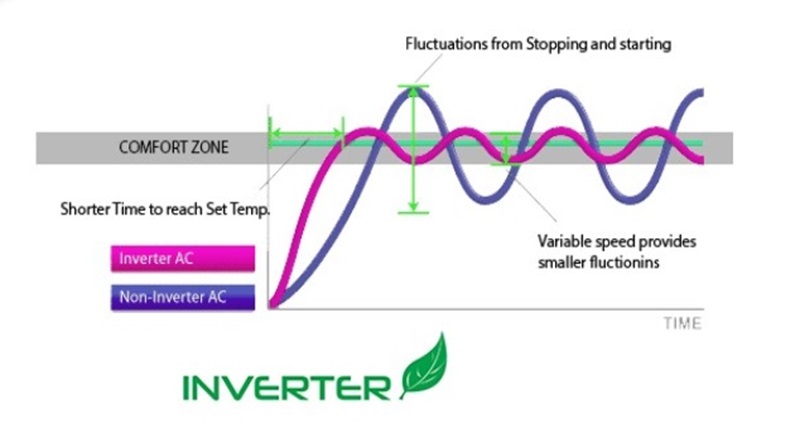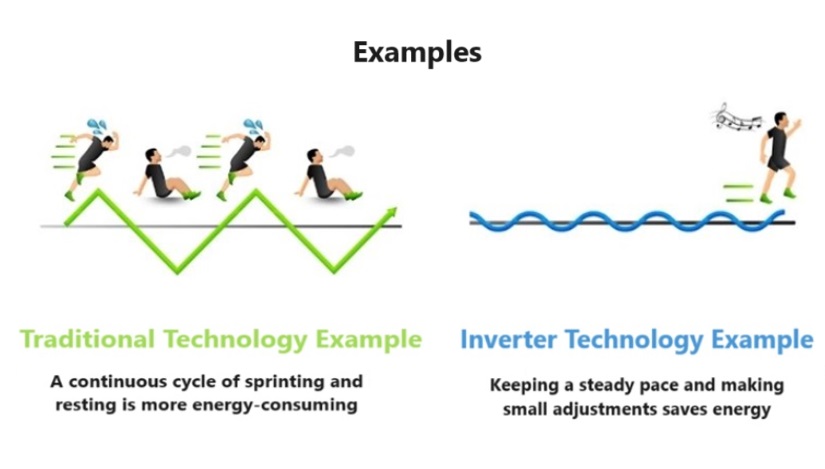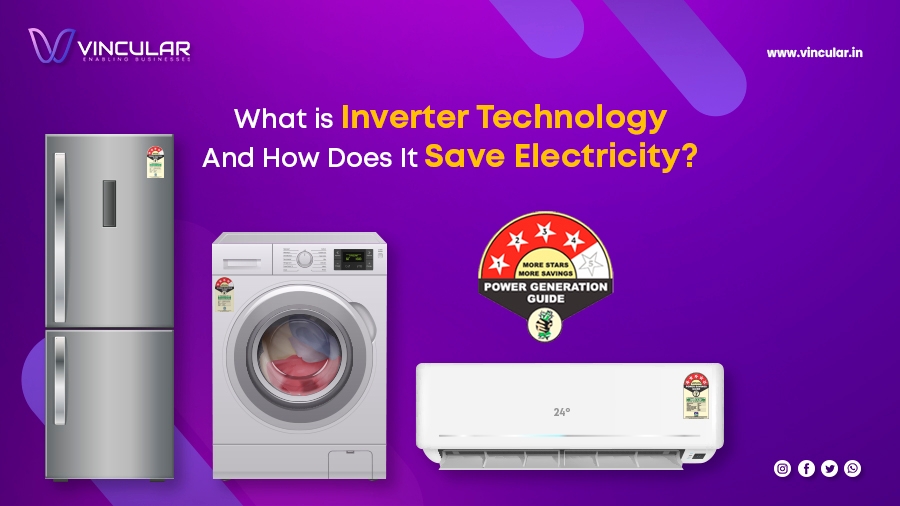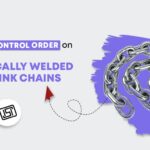Inverter technology was invented by a multinational Japanese electronics company – Toshiba in 1980.
This game-changing technology has revolutionised how we use electrical appliances in our homes and offices and has become increasingly popular in recent years.
From air conditioners to refrigerators, this technology has become the most opted technology in the world offering many benefits over traditional technologies.
Now, you might be wondering, if you have heard of inverter technology but don’t know what it is and how it works.
In a nutshell, it alters the way your appliances consume power, making them more energy-efficient and cost-effective.
But if you want to know about what inverter technology is then keep reading because we are going to delve comprehensively into inverter technology, exploring its advantages, how it works, and why it is preferred over non-inverter technology.
What is Inverter Technology?

Inverter technology is a type of technology used in various electronic devices and appliances, including air conditioners, refrigerators, washing machines, and more.
The primary purpose of inverter technology is to control the speed and power of the electric motor within these devices, leading to more efficient operation and energy savings.
Traditional appliances often use on/off mechanisms to control the operation of their motors.
For example, a refrigerator or an air conditioner compressor may run at full speed until the desired temperature is reached and then turn off completely.
When the temperature deviates from the set point, the motor starts again at full power.
In contrast, appliances equipped with inverter technology use variable-speed motors.
Instead of running at a constant speed or turning on and off abruptly, the motor speed can be adjusted continuously based on the required load or demand.
This allows the device to operate more efficiently and adapt to changing conditions.
How Does Inverter Technology Work?
Imagine you have a regular fan at home. When you turn it on, it runs at a constant speed, right?
It doesn’t matter if it’s too hot or just a bit warm in the room – the fan keeps spinning at the same speed.
Now, let’s talk about inverter technology.
An inverter is like a smart controller for electronic devices, such as air conditioners or refrigerators.
Instead of running at a fixed speed like the regular fan, devices with inverter technology can adjust their speed or power based on the need.
Here’s How it Works
1. Sensing the Need: Inverter technology is like having a built-in brain.
It can sense how hot or cold it is and how much work needs to be done.
For example, if you set your air conditioner to a certain temperature, the inverter can figure out how much cooling power is required.
2. Adjusting Power: Unlike regular devices that turn on and off to maintain a constant temperature, inverters can change their power output.
If it’s really hot, the inverter will work harder to cool the room quickly. If it’s just a bit warm, it will operate at a lower power level, saving energy.
3. Energy Efficiency: The cool thing about inverter technology is that it’s more energy-efficient.
Since the device doesn’t have to constantly start and stop, it uses just the right amount of power needed at any given moment.
This not only saves energy but also helps the device work more quietly.
So, in simple terms, inverter technology is like having a smart and adaptable helper for your electronic devices.
Moreover, it adjusts its efforts based on what’s needed, making your appliances more efficient and often saving you money on energy bills.
Now, let’s delve into a comparative analysis between inverter technology and old (conventional) Technology.
Inverter Technology Vs. Traditional Technology
Comparing inverter technology with traditional (conventional) technology in the context of various applications.
|
Categories |
Inverter Technology |
Old (conventional) Technology |
| Energy Efficiency | Regulate the speed of the compressor motor, resulting in better energy utilization. | Operate at a fixed speed, leading to higher energy consumption when full power is not required. |
| Speed Control | Offers variable speed control, allowing for precise adjustments according to the load requirements. | Operates at fixed speeds, resulting in less flexibility in adapting to varying loads. |
| Operation | Provides smoother operation, reducing wear and tear on components. | Typically uses on/off controls, leading to more frequent starts and stops. |
| Noise Levels | Generally produces less noise due to the ability to control the speed of motors based on the load. | Often produces more noise, especially during start-up and shutdown phases. |
| Lifespan | Generally has a longer lifespan as the variable speed operation puts less stress on components. | May experience more wear and tear due to fixed-speed operation, potentially leading to shorter lifespans. |
| Maintenance | Requires less frequent maintenance due to reduced wear and tear. | May require more frequent maintenance. |
| Flexibility | More adaptable to varying loads and environmental conditions. | Less flexible in adapting to changing conditions. |
| Adaptability | Suitable for applications with fluctuating power requirements. | May need to be more efficient in applications with variable loads. |
How Does Inverter Technology Help in Saving Electricity?

- Inverter-driven devices can adjust the power output according to the actual demand.
- Inverter technology helps reduce the power surge by starting the motor gradually, leading to lower energy consumption.
- Inverter-driven motors can maintain a more constant speed, which is often more energy-efficient than non-inverter motors’ frequent starts and stops. This results in a more stable and energy-efficient operation.
- In appliances like air conditioners, inverter technology allows for quicker temperature adjustments since the motor doesn’t need to stop and start repeatedly. This can lead to faster cooling or heating cycles and, in turn, more energy savings.
- The smoother operation of inverter motors can reduce wear and tear, contributing to a longer lifespan for the appliance.
Appliances Adopting Inverter Technology
1. Air Conditioner (AC): Inverter ACs use variable-speed compressors with an inverter circuit to modulate the speed of the compressor motor.
2. Refrigerator: In inverter refrigerators, the compressor is equipped with an inverter-driven motor, allowing it to operate at variable speeds.
The inverter adjusts the compressor speed based on the cooling demand with the help of feedback sensors.
This continuous regulation of the compressor speed results in more precise temperature control, reduced energy consumption, and quieter operation.
3. Washing Machine: Inverter washing machines incorporate a variable-speed motor controlled by an inverter circuit.
4. Microwave Oven: In inverter-based MWOs, an inverter circuit controls the power output by modulating the frequency of the generated microwaves.
In essence, Inverter Technology encompasses several key aspects:
- Use of variable speed motor
- Converting direct current (DC) to alternating current (AC)
- Controlling the output frequency and voltage through feedback sensors according to the current requirement
Looking at this, you’ll see that inverter technology is used in many big appliances, making it a smart and practical choice.
Conclusion
Inverter technology, introduced by Toshiba in 1980, is a game-changing innovation in electronic devices.
It controls the speed and power of electric motors, making appliances more energy-efficient.
This adaptability reduces energy consumption, noise levels, and wear and tear on components.
The technology is widely adopted in appliances, offering consumers efficient and flexible options for everyday use.
In summary, inverter technology represents a smart and practical choice, contributing to energy savings and improved appliance performance.
Note: If you want the latest regulatory news and notifications, then follow our WhatsApp Channel or watch our Publication Space.





